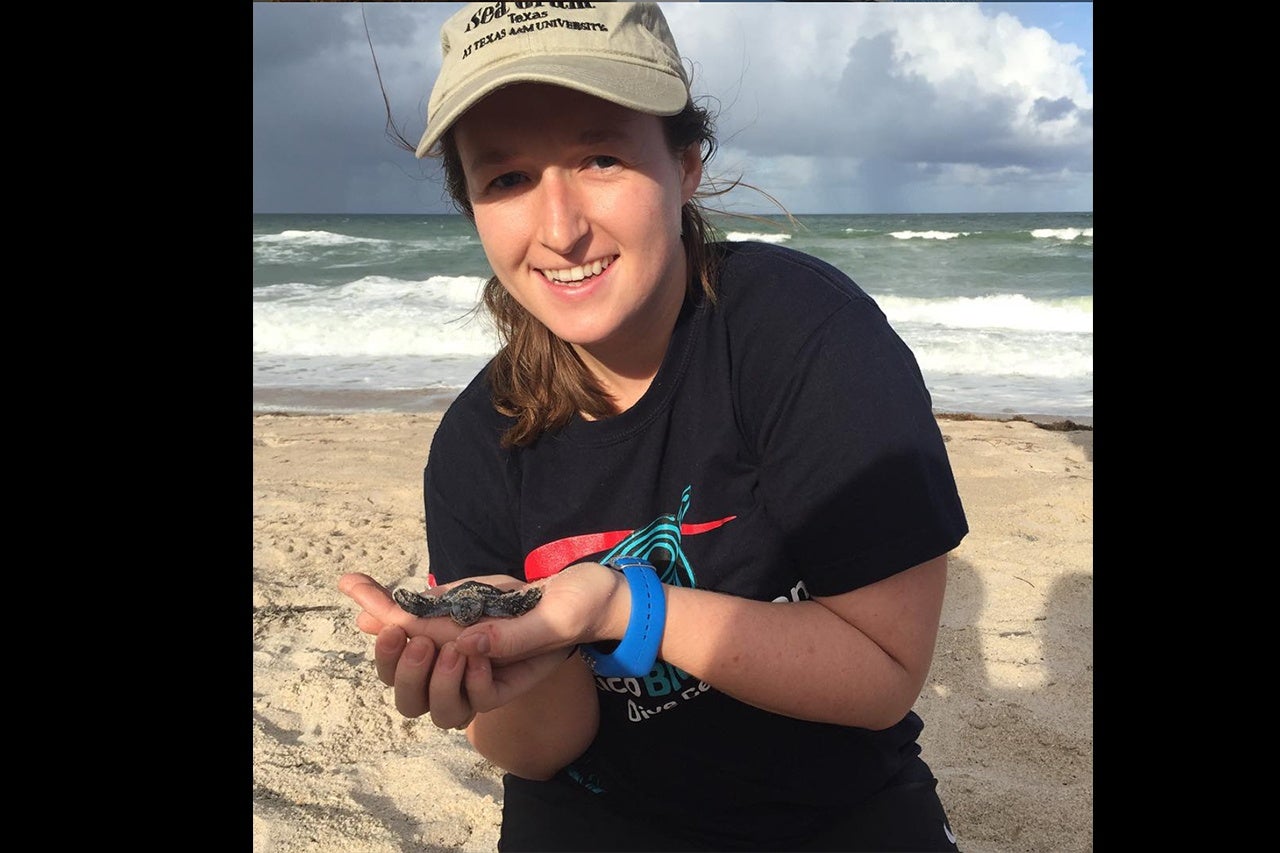Photogenic pygmy owls, bumble bee habitats and endangered sea turtles might attract more attention, but – when it comes to her work as the rare and listed species grant coordinator for the Texas Parks and Wildlife Department (TPWD) – land acquisition is what Chelsea Acres ’18 (M.S.) appreciates most.
“I think that, dollar for dollar, the best way to conserve species is to set aside land – because we can do research all day long, and it’s very important to do so, but the biggest actual changes we can make are to conserve land,” Acres says. She works with an annual budget of approximately $1.75 million covering about 60 grants a year. “I like those grants. I feel like I’m doing a whole lot for Texas wildlife.”
Acres works with several different types of grants including those that help endangered and threatened species and species of greatest conservation need. They can also help conservation organizations protect land through easements and fee-simple transactions. These complex land acquisition and protection efforts make even more sense when you consider that almost 96 percent of Texas is privately owned land. Monuments, city parks, conservation areas – all of the federal, state and local government–owned lands in Texas – make up the remaining 4.2 percent, one of the lowest percentages of public lands, by state, in the nation.
Operating out of TPWD’s Austin headquarters, Acres handles some of the things you might expect from a grant coordinator: She organizes the grant process, which covers everything from being a point of contact to writing and posting requests for proposals; she reviews grants and helps select awardees; she works on grant objectives, researches outcomes and monitors progress; she works on annual financial and performance evaluations; and she closes grants and generates final reports.
In addition to this combination of science, conservation and project management, Acres loves her job because she gets to work with a wide range of projects as opposed to being limited as a researcher working on one grant for a fixed amount of time.
“Just the fact that I get to directly impact wildlife conservation in the state, but I don’t have to do the research myself, is really fun,” Acres says, noting that her work is focused on all non-game species. “I get such a wide view of what is happening across the state because I manage the projects for the whole state in just this one section.”
And, for Acres, there’s a personal angle as well. Even though she grew up in Weatherford, Texas (population 30,895), she didn’t develop her love for animals, the environment and conservation in Weatherford’s public spaces and parks because most of Weatherford, like most of Texas, is private land. Acres’ interests were sparked during trips to nearby Mineral Wells State Park and Dinosaur Valley State Park – and most especially from watching nature specials on PBS – including a series produced by the TPWD itself.
“I grew up watching Texas Parks and Wildlife on Saturday mornings, so being at TPWD is a point of pride for me,” says Acres of the PBS show, which has been on air for 36 years.
Texas Parks and Wildlife wasn’t all Acres loved to watch growing up.
“I was obsessed with the movie Free Willy. From a young age, I was obsessed with whales, and dolphins, and the ocean,” she recalls, adding that she earned her scuba certification as young as possible – and not just the junior certification. “I learned how to scuba dive in muddy Texas lakes just so I could get certified.”
When the time came to go to graduate school, Acres, who earned her bachelor’s degree in wildlife and fisheries sciences from Texas A&M University, was equally obsessed with finding coastal universities that offered students research projects working with cetaceans (i.e., whales, dolphins, porpoises). She found that opportunity at the College of Charleston, where she researched dolphins while earning her master’s in environmental and sustainability studies.
“I really liked that whole intersection with science and policy the program offered – that was great as far as just content,” she says.
The College’s Environmental and Sustainability Studies (EVSS) Program is interdisciplinary, with six departments – biology, geology and environmental geosciences, mathematics, physics and astronomy, political science and economics – contributing to its curriculum. For Acres and her career, it was the law and policy classes she took in the EVSS Program that have had a lasting impact.
“The classes helped me learn how to read government documents, how to read case law – and that translates to a lot of usefulness for me, because now I read federal code and federal law all the time to make sure we’re upholding that. It was also just kind of fascinating to learn about different cases that have been foundational for how we organize our system for wildlife – especially if you’re looking at how we fund stuff,” she says, explaining that the United States funds wildlife research and wildlife management according to the North American model for wildlife funding. “That’s all legal based.”
During her time at the College, Acres was an officer in MESSA – the M.S. in Environmental and Sustainability Studies Student Association – and worked at the South Carolina Sea Grant Extension Program.
“There are really big opportunities for networking at the College if you take advantage of them,” says Acres, noting that – in addition to access to great faculty, Grice Marine Lab and Medical University of South Carolina laboratories – students in the EVSS Program have a unique camaraderie. “I really liked the size of the program. It’s pretty small, so you pretty much know everyone, which I had never experienced before. I’ve never had that close-knit small-program feel before – and I think that is really beneficial for grad school in particular. It was good to have that kind of smaller group – and I’m still really good friends with most of them. We talk on a frequent basis and help each other out.”
Looking ahead, Acres wants to take on greater responsibilities in conjunction with the proposed Recovering America’s Wildlife Act (RAWA) – federal legislation that would boost Texas’ share of conservation monies to $50 million annually, a game-changing amount that would have an enormous impact on species and habitat conservation.
“It’s really cool because it’s a bipartisan bill, which doesn’t happen very often. And it’s somewhere like $1.4 billion for the entire United States,” she says. “I would like to be involved in that if it were to pass – and hopefully it will soon!”




